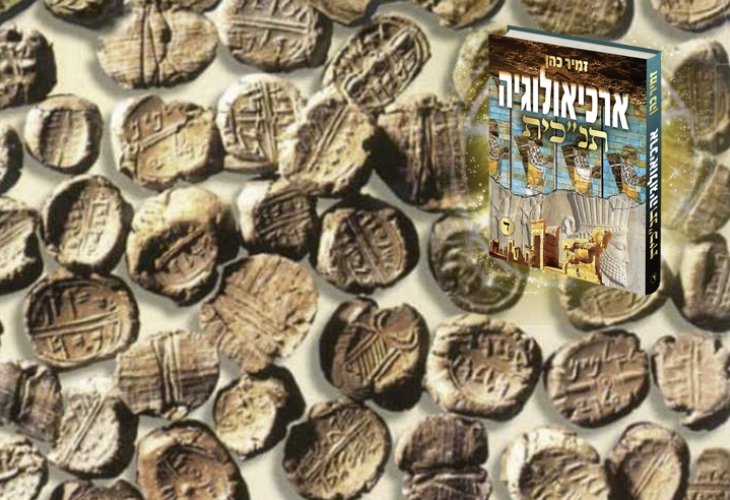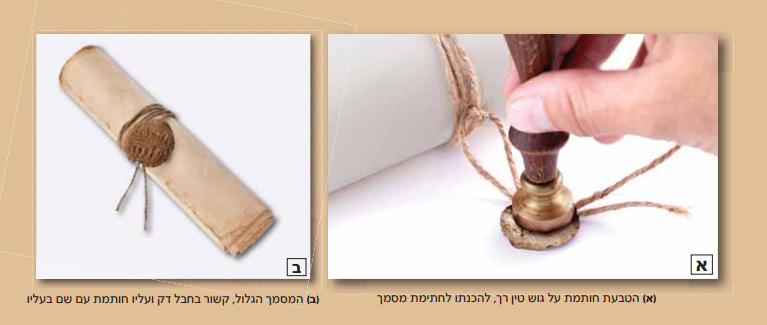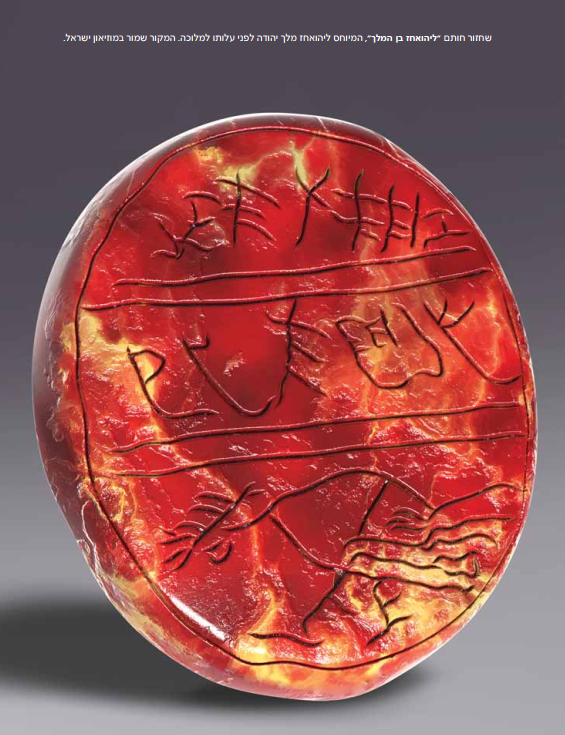Uncovering Ancient Seals: Traces of Judah's Bureaucracy
How did ancient seals come to light, and why are they significant? Here are some notable seal discoveries through the years. A glimpse from the book 'Biblical Archaeology,' Part IV.
 Some of the seal impressions from the Kingdom of Judah, discovered by Prof. Yigal Shiloh in the 'City of David' (Photo: Ilan Shtulman)
Some of the seal impressions from the Kingdom of Judah, discovered by Prof. Yigal Shiloh in the 'City of David' (Photo: Ilan Shtulman)In ancient times, seal impressions were a common means of verifying the authenticity of important documents and marking ownership or other significant information on objects. As referenced in the Bible:
"And she wrote letters in Ahab's name and sealed them with his seal."
"Written and sealed with the king's ring."
This practice is also mentioned in the Mishnah:
"Earth [red clay] as the seal of roof tiles [- seal on merchandise bags]; Rabbi Akiva's words. And the Sages say: as the seal of letters [- smaller]."
How were documents sealed? Letters and certificates written on parchment or papyrus were rolled into a scroll and tied with a thin cord or string to prevent unauthorized opening before reaching their destination. A small lump of soft clay was attached to the knot, and a seal bearing the writer's or document owner's name, his father's name, and sometimes his position or title, was pressed into it while the clay was still moist.
 (A) Stamp impression on soft clay, ready for sealing a document (B) The rolled document, tied with thin cord and bearing a seal with the owner's name
(A) Stamp impression on soft clay, ready for sealing a document (B) The rolled document, tied with thin cord and bearing a seal with the owner's nameThe text was often written in script without vowels or silent letters (for example: "Yerahme'el" instead of "Yirhamael"), and sometimes without spaces ("Benevi" instead of "Ben Navi"), likely to save space on the small seal.
Very small seals were usually carried on rings to prevent their loss and to facilitate use.
Additionally, jars or bags containing food, drink, or other important contents were sealed with wet clay stoppers. For identification and security, a seal with the owner's name was impressed onto the stopper. Sometimes the seal was also impressed on the jar's handle.
Once the clay dried, the document or container could not be opened without breaking the seal impression, as mentioned in the Bible:
"As the word of the sealed book [Rashi: a letter sealed with wax. (Instead of clay)], they present to a knowledgeable one in the book, saying: Please read this! And he replies: I cannot, for it is sealed [Rashi: I cannot see inside, for it is sealed]."
The Room of Seals
The most telling evidence of prominent figures operating in the governance district during the Kingdom of Judah is a collection of fifty-one seal impressions found in a structure very close to the House of Ahiel. Most seals bore Hebrew names, some of which belonged to officials and high-ranking ministers mentioned in the Bible during the Kingdom of Judah. The building likely served as an office or royal archive, where documents written on parchment or papyrus were kept. The great fire during the Babylonian destruction consumed the documents, but the clay seals hardened due to the intense heat, preserving them for many years.
The archaeologist who discovered this collection of rare seal impressions is Prof. Yigal Shiloh, who excavated in the City of David from 1978 to 1985. His explanation of the seals provides a fascinating glimpse into the Biblical narrative:
"After removing the layers from the Roman and Hellenistic periods, which covered most of the slope, the excavators reached the top of the destruction debris of the House of Seals, which is part of the overall destruction of the city by the Babylonians in 586 BCE. In this destruction layer was found a rich assemblage of artifacts... Those three days of excavation in this section were days of great excitement for the expedition members. As mentioned, fifty-one seals were found... appearing on them are fifty-one Hebrew names... the formula is identical for all, like, for instance, 'Azaryahu son of Hilkiah,' meaning: [the seal of] Azaryahu son of Hilkiah... In the seal collection from the City of David, no theophoric element [a religious connection] that is not Israelite was found... The archaeological evidence for the city's destruction, based on architectural details and small objects, is well anchored in the historical sources and aligns with the description of Jerusalem's destruction in the Bible...
 Reconstruction of the seal 'Yehoahaz son of the king,' attributed to Yehoahaz king of Judah before ascending the throne. The original is preserved at the Israel Museum (3D and rendering: Sari Shwartzbart)
Reconstruction of the seal 'Yehoahaz son of the king,' attributed to Yehoahaz king of Judah before ascending the throne. The original is preserved at the Israel Museum (3D and rendering: Sari Shwartzbart)The House of Seals adds a human dimension to the material archaeological findings and enriches the story of the city's end, as a seal impression of Gemariah son of Shaphan the scribe, who served in Jehoiakim's court eighteen years before the destruction, was discovered there, along with other figures mentioned by Jeremiah: Baruch son of Neriah the scribe, Seriah son of Neriah his brother, and Jerahmeel the king's son.
Indeed, we must conclude this discussion on a personal note and join the sentiments expressed eloquently by Prof. Nahman Avigad in one of his essays: 'I cannot help but express my internal feeling while handling these seals and decoding them for the first time. You feel a kind of personal connection with the significant figures who took an active part in these dramatic events, like Jeremiah and Baruch, during the difficult time leading up to the fall of Judah.'"
These are the words of Prof. Yigal Shiloh.
Another verification with the Bible was found when it was noted that the seals were discovered in pottery jars with holes at their bottom. It is speculated that the sealed documents were intentionally placed in these jars for long-term preservation, as described in Jeremiah:
"Take these documents: the deed of purchase, sealed, and this open document, and place them in an earthen vessel, so they may last for many days."
 (Photo: Zeev Radovan)
(Photo: Zeev Radovan)The hole was made to drain moisture that would otherwise accumulate in the containers and damage the documents.
Examinations of the seals found in the City of David disclosed that all were made from the same clay, "terra rossa" soil found in Jerusalem and its surroundings, indicating they were most likely produced in this area, for individuals residing in Jerusalem and its vicinity.
Regarding the designs on the seals, Prof. Nahman Avigad points out that the Kingdom of Judah adopted a modest approach to decorative elements on seals: "It is worth noting the absence of any decorations... in most seals from Judah from the late First Temple period."
The Seal of the 'City Official'
A rare and significant discovery was made during excavations by the Israel Antiquities Authority at the Western Wall Plaza in 2017: a seal impression from the First Temple period that belonged to the "City Official" of Jerusalem – the highest municipal position in Jerusalem during the First Temple era, approximately two thousand and seven hundred years ago.
According to Dr. Shlomit Weksler-Bdolah, director of the excavation, "The seal impression may have accompanied the delivery of something important, serving as a kind of 'logo' or a small souvenir, attached to deliveries on behalf of the City Official." She notes that "the discovery of an impression bearing this high title, and the collection of seals previously found in this structure, enhances the impression that here, in the area of the current Western Wall Plaza, on the western slope of ancient Jerusalem and about a hundred meters west of the Temple Mount, was a residential area for those holding senior positions in Jerusalem at the end of the First Temple period."
Weksler-Bdolah adds that it is archaeological evidence of the Biblical account of a City Official in Jerusalem before approximately two thousand and seven hundred years. Prof. Tali Ornan of the Hebrew University and Prof. Benjamin Sass of Tel Aviv University, who studied the seal impression, note that "the title 'City Official' is known from the Bible and extra-Biblical documents and refers to someone managing the city on behalf of the king, akin to today's 'mayor'. This role existed in Jerusalem and other cities. Here are some examples:
"And the king of Israel said, 'Take Micaiah and return him to Amon the City Official."
"When Zebul the City Official heard the words of Gaal son of Ebed, he was furious."
"In the eighteenth year of his reign, to purify the land and the house, he sent Shaphan son of Azaliah, and Maaseiah the City Official, and Joah son of Joahaz the recorder, to reinforce the house of Hashem."
Additional seal impressions with the inscription "City Official" have been discovered previously in Israel and are preserved in museums and various collections around the country.
To purchase the book 'Biblical Archaeology', Part IV, click here.

